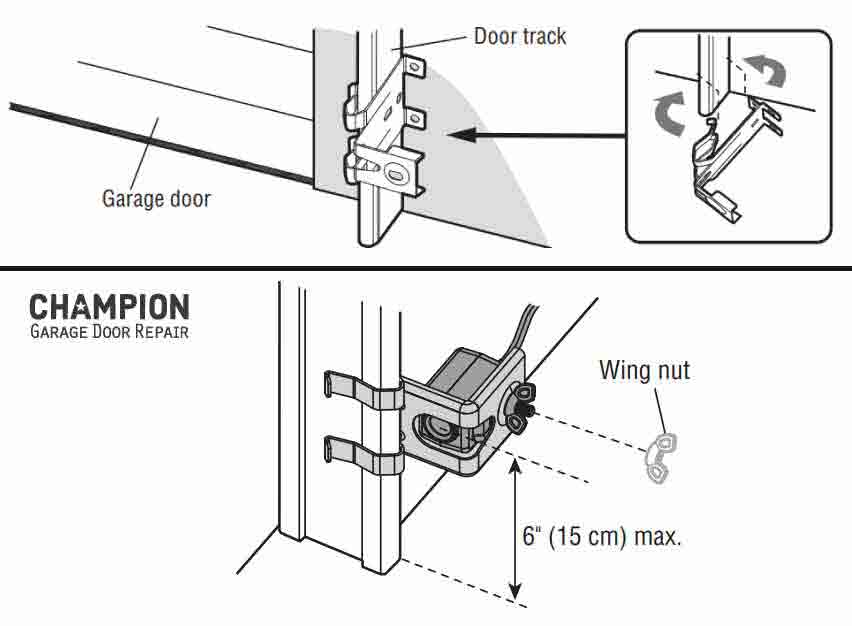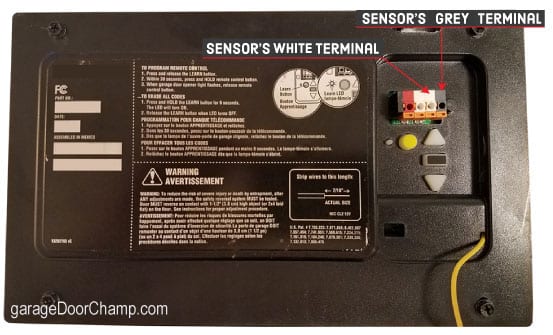A garage door may fail to close due to various factors, but the good news is that many problems can be resolved with a few simple steps. Here, we’ll explore the most common reasons why your garage door isn’t closing and how to fix them.
Table of Contents
- Broken or Misplaced Garage Door Cables
- Broken Roller or Roller is Off the Tracks
- Broken or Loose Hinge
- Broken Spring
- Obstructions in the Doorway
- Garage Door Won’t Close from Outside
- Garage Door Won’t Close with Remote
- Faulty Garage Door Sensors
- Malfunctioning Garage Door Opener
- Bent or Damaged Door Sections
- Imbalanced Garage Door
1. Broken or Misplaced Garage Door Cables
A cable that is broken or off the pulley will cause the tension from the torsion spring to affect only one side of the door. As a result, the door will appear crooked and will not close. Inspect the pulleys and door cables for breakage. If the cable is broken or frayed, replace it with a new one. The replacement cable should be selected based on the height of the garage door and the type of drum it uses.
If one of the cables is off the pulley, release the door from the opener using the manual release. Lift it all the way up and secure it in place by blocking the tracks with locking pliers, ensuring that both ends of the garage door are leveled with each other.
Mark the location of the pulley’s locking bolt with a marker. Release the locking bolt using 7/16 inch (11mm) 12 points wrench, then remove and straighten the cable. Reinsert the cable tip into the pulley’s slot, ensuring it is securely fastened to both the pulley and the bottom bracket lip. Begin rotating the pulley in the correct direction, tightly wrapping the cable in the pulley’s groove. Once completed, retighten the pulley’s locking bolts to their original marked location.
If the door remains slightly crooked or if there are any gaps between the garage door and the floor after repairing the door cable, reset the torsion assembly, recalibrate the springs, and balance the door as necessary.
2. Broken Roller or Roller Is Off the Tracks
A broken roller or a roller that has come off the tracks can obstruct the proper functioning and closing of your garage door. Thoroughly inspect the garage door rollers for any visible signs of breakage or wear. Carefully replace any worn or broken rollers as necessary.
If one or more of the rollers is off the track, reinstall them by either removing the hinge and reinstalling it once the rollers are back in the track. Alternatively, you can gently bend the track with a claw hammer. Press the rollers back into place through the gap, and use the hammer to restore the track to its original position.
3. Broken or Loose Hinge
A malfunctioning hinge, often those on the left or right-hand sides, can prevent the garage door from closing. This issue may arise when the hinges obstruct the proper interlocking of door sections or when the hinge’s roller binds against the track. Inspect the door for broken hinges or loose screws. Retighten the screws or replace any broken hinges, ensuring that the replacement hinge corresponds to the existing hinge numbers.
4. Broken Spring
As the garage door becomes extremely heavy when the spring breaks, the opener’s module senses the excessive pressure and prevents the door from closing, especially in newer opener models. Inspect the torsion springs for any signs of breakage.
If the spring is broken, purchase a replacement based on the current spring measurements. Measure the inside diameter, length, and wire diameter of the spring. It is recommended to use a designated micrometer for accurate measurements, or take the springs with you to a local springs supplier, as using a ruler and counting coils often leads to incorrect wire diameter measurements.
To replace the broken spring, you’ll need two winding bars, two locking pliers, a 7/16-inch (11mm) 12-point wrench, an impact driver, and a 3/18-inch impact socket. If you have more than one spring, start by unwinding any unbroken springs using a 7/16-inch (11mm) 12-point wrench and winding bars. Release the pulleys, then slide the torsion tube out of the end bearing plate.
Release the broken spring from the anchor bracket using an impact driver and a 3/18-inch impact socket, and slide it out. Insert the new spring and reassemble the torsion assembly. When winding up the springs, ensure one revolution for each spring per one foot of door height. Test the door balance and adjust the spring tension as needed.
5. Obstructions in the Doorway
Sometimes, the solution can be surprisingly simple. Items like brooms, boxes, or loose bolts can obstruct the garage door’s path, preventing it from closing. Inspect the garage door along the tracks and ensure there are no obstructions in its path.
6. Garage Door Won’t Close from Outside
A garage door that experiences intermittent functionality with remote controls may suggest a frequency interference issue. The following signs often indicate problems related to frequency interference with your garage door:
- Remote controls might open the garage door but fail to close it, or vice versa.
- Remote controls work only from a close distance, work intermittently, or do not work at all.
- The garage door opener has range problems.
To address this issue and identify the source of interference, start by unplugging all appliances and electrical devices in your garage and home, then test the garage door opener. If the problem is resolved, it’s likely that one of the appliances is interfering with the garage door opener frequency.
To identify the specific interference source, systematically plug back the appliances one at a time, testing the garage door opener after each addition until you pinpoint the source of interference.
If you cannot locate the source of interference, update the opener frequency to a Tri-Band of 310 MHz, 315 MHz, or 390 MHz by retrofitting a receiver. Alternatively, you can replace your garage door opener with a model that supports the Tri-Band frequency.
7. Garage Door Won’t Close with Remote
If your garage door fails to close using the opener remote, attempt to operate it using either the wall console or a different remote. If the garage door closes with the wall button but does not respond to the remote control, potential causes include a drained battery in the remote, a defective remote, an activated vacation mode, or a faulty opener receiver.
Ensure that the opener’s vacation mode is turned off by accessing the opener’s wall console. Locate the button with the lock symbol and press it to enable or disable the vacation mode feature.
Attempt to use any other remotes you have. If they are operational, replace the batteries in the non-functioning remote. Alternatively, purchase a replacement remote based on your opener’s manufacturer and model number. To program a new remote, press the opener’s learn button and then the button on the remote you wish to program, or follow the manufacturer’s programming instructions for your specific model.
If the garage door does not close with the remotes but closes when holding down the wall button, it is likely that the safety sensors are malfunctioning.
8. Faulty Garage Door Sensors
The following signs often indicate that the safety sensors are blocked, misaligned, or experiencing issues:
- The garage door starts closing but then reverses back up, typically accompanied by the opener’s light bulbs flashing a few times and the opener emitting a clicking sound.
- The garage door will close when holding down the wall button but won’t close using the remotes.
- The opener is displaying the following error codes: 1-1, 1-2, or 4-6. Some openers may have a red warning light.
- The sensors indictor lights are off or flashing.
To fix faulty sensors, begin by ensuring there are no objects obstructing the sensors’ infrared beam and clean the sensors’ lenses with a dry washcloth.
Each sensor is equipped with an indicator light. The sending sensor features a yellow or orange LED light, while the receiving sensor has a green or red LED light. Both lights should be visible and solid when the sensors are properly aligned, unobstructed, and functioning correctly.
Make sure both indicator lights are on, assuming there are no objects blocking the path between them. If the green or red LED light on the receiving sensor is off or flashing, carefully adjust the safety eyes or their brackets until the light reappears and remains solid.

If the sensors are receiving intermittent power, inspect the connection points and wiring. Ensure the wires are properly connected to their respective terminals and that the connection points are not damaged. Look for any signs of damage or separation in the wires.

Intense sunlight can interfere with the sensors’ ability to detect the infrared beam properly. Replace the sensors if your garage door won’t close during the day, when the sun rays are directly affecting the sensors.
Testing the Sensors Directly via the Motor Unit
Testing the safety eyes directly via the motor unit allows you to determine whether the garage door won’t close due to defective sensors or a short wire.
First, remove the sensors from the brackets. Cut the wire, leaving approximately 12 inches of wire from the end. The sensor wire has two strands; carefully pull the strands apart. Strip around half an inch of insulation off the end of each wire strand.

Make a note of how the wires are connected to the opener terminals. Disconnect the existing wires and connect the sensors instead. Point the sensors directly towards each other at a close distance. If the sensors’ indicator lights remain off, it suggests a potential defect in either the sensors or the opener’s motherboard.
If the sensor lights turn on and remain solid, maintain their alignment and attempt to operate the garage door to ensure it closes correctly. Replace the wires leading to the sensors if needed. If the wires are concealed behind walls or in crevices, replace them by running a new wire externally, using 24/2 low voltage replacement wiring. Connect the replacement wires to the appropriate garage door opener terminals and use a staple gun to secure the wires to the ceiling and wall.
9. Malfunctioning Garage Door Opener
There are various reasons why your opener may not close the garage door, including a worn belt, worn gears or sprocket, a defective limit switch or travel module, uncalibrated opener force, and a worn opener motor. Begin by inspecting the opener’s mechanisms for any visible wear or breakage. Then, troubleshoot the error code being signaled by the opener. Consult the owner’s manual and replace any defective opener parts as necessary.
10. Bent or Damaged Door Sections
The deterioration of door sections, whether due to bending, wear, or cracking, weakens the structural integrity of the door. This can result in buckling during the closing process, causing the sections to give way under the load. Consequently, the door sections may not interlock or align as they should, preventing the garage door from closing properly.
In most cases, worn garage door sections can be repaired using designated reinforcement struts and recalibration of the springs and electric opener. However, some cases require the complete replacement of the worn sections.
11. Imbalanced Garage Door
A garage door that isn’t balanced properly can exert excessive force on the opener’s motor or RPM sensor, preventing it from closing. You can test the garage door’s balance by disconnecting the door from the opener using the manual release while the door is closed. Lift the door to waist or shoulder level. The door should neither slam shut nor pull up. Make any necessary adjustments or replace the springs.
What to Do if Your Garage Door Isn’t Closing
If there’s no sign of breakage, disengage the garage door from the opener using the emergency release pull. Slowly operate the garage door up and down to assess its movement. In some cases, disconnecting the door from the opener also allows you to manually close it until the problem is fixed.
If you’re not sure how to fix the issue or don’t have the proper tools, contact a licensed garage door repair company that offers same-day service. Leaving a garage door open or even partially open can pose significant security and safety risks.








My garage door won’t close, and I’m not sure what to do. It makes sense that I would want to get a professional to look at it. They would be able to determine what is causing the problem.
Frustrating. Garage door will go up but not come down when using remote. Pressing wall mount it closes. Green lights are on on both sensors. Still don’t understand what problem could be. Could green lights both be on and still be defective?
Hello Irene,
Do you need to press and hold the wall button while closing the garage door? Is the light bulb on the unit flashing few times? These are signals that there’s a malfunction with the safety eyes. Try to realign/adjust photo eyes (located on bottom of vertical tracks, left and right hand side) and check electric wiring for any damage.
I have the exact problem as Irene! I do not have to long press the wall button, and the sensors on both sides of the door are green. If I step inbetween them, one does go off. The door works perfectly from the wall. brand new batteries, brand new remotes, been reprogrammed according to the manual. help!?!
Hello there, thanks for reaching out.
Is the operator’s light bulb flashing few times once door reversed? If it does, it may indicate that there’s an issue with the safety system/safety eyes. Try to take a closer look on the eye’s LED light while it’s darker in the garage, sometimes it will flicker slightly and would be difficult to see from a distance. Also, the sun shining directly on the sensor’s lens may cause the garage door opener to reverse.
If the operator’s light bulb isn’t flashing once door reversed, release the door to manual mode while it’s fully closed, raise and lower it by hand to check for any obstructions and that the door is correctly balanced. If door travels smoothly up and down, adjust the unit’s force and sensitivity.
I’ve been having issues with my garage door for quite some time. I’ve had a company out to look at it numerous times, only to temporarily fix it, and then it stops working again. The garage door will only go up, but will not close at all without holding down the wall button. Both sensors are solid, one green and one orange, so I’m not sure what the issue is. At this point, I’m thinking that either the sensors have become defective or something else has.
Hello Elena,
The issue can be one of the following:
1. Faulty sensor.
2. Sensor misalignment.
3. Sensor’s damaged electrical wire shorting out.
4. Loose connection on operator’s mother board.
Try to look closely at the receiving sensor’s LED light (green) when it’s darker in the garage. Occasionally, the LED light flickers very slightly which may indicate a faulty sensor or misalignment.
what is the minimum time of breaking the safety beam to cause reversing of the door my daughter is buying a house i say it is momentary the broker says its fine for it to take a couple seconds
As long as the garage light on the opener is on, the opening and closing of the door cannot be activated by the remote. Once the iight goes out, it does open/close. I took the two bulbs out, and the problem remains
Hello Cecil Boyd,
You may have a frequency interference issue (solutions can be found here), or perhaps an electrical problem with the garage door opener unit (this will need further on-site troubleshooting).
My garage door closes fine in the daytime but at night after dark it wont close if the bright overhead florescent lights are on. It starts to close and then reverses. Closes ok if I turn off the lights at night. Also closes fine with lights on in the daytime. Its a LiftMaster contractor series
I thought that I could fix my broken garage door by just adjusting something with a screwdriver. Turns out this is much more complicated lol